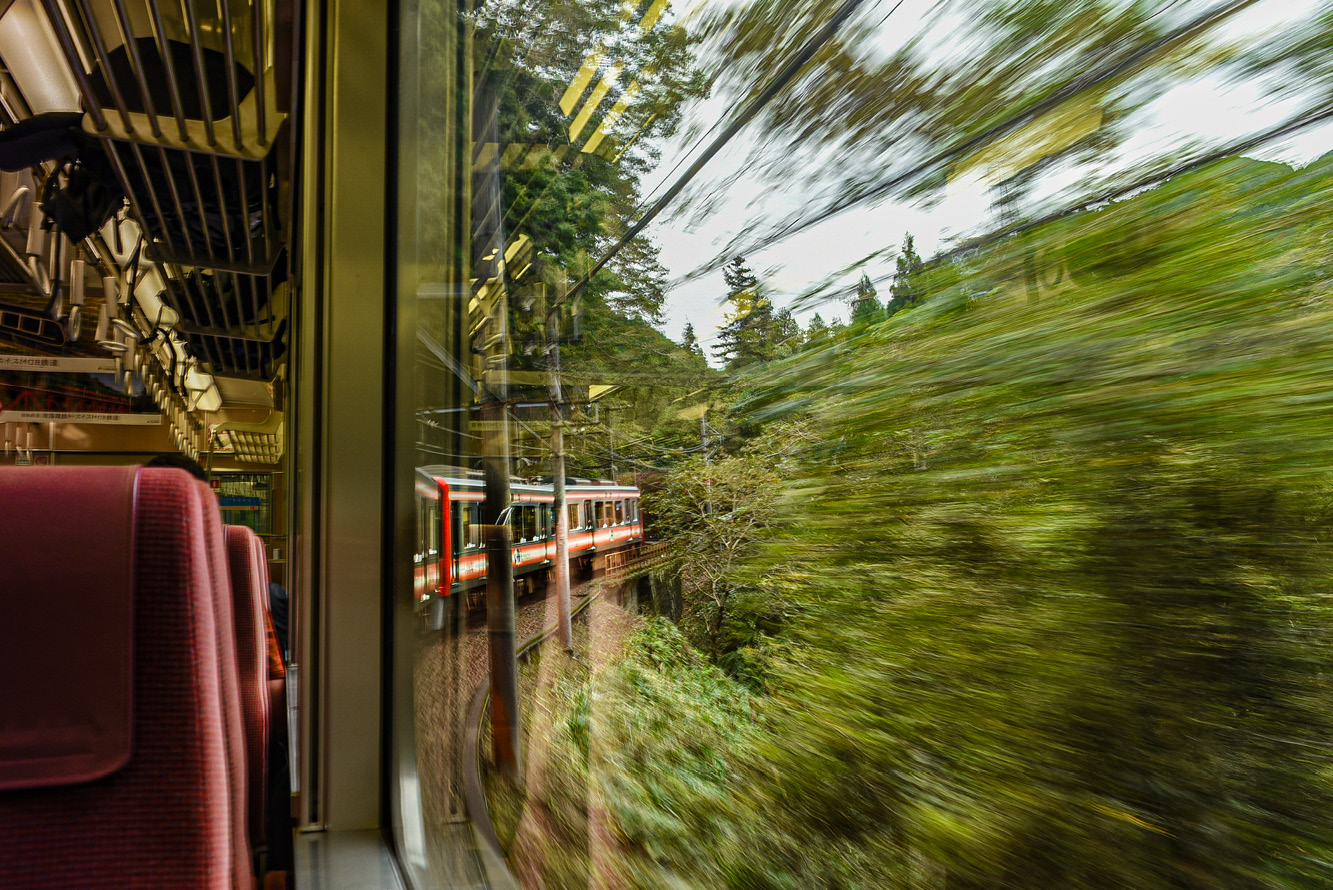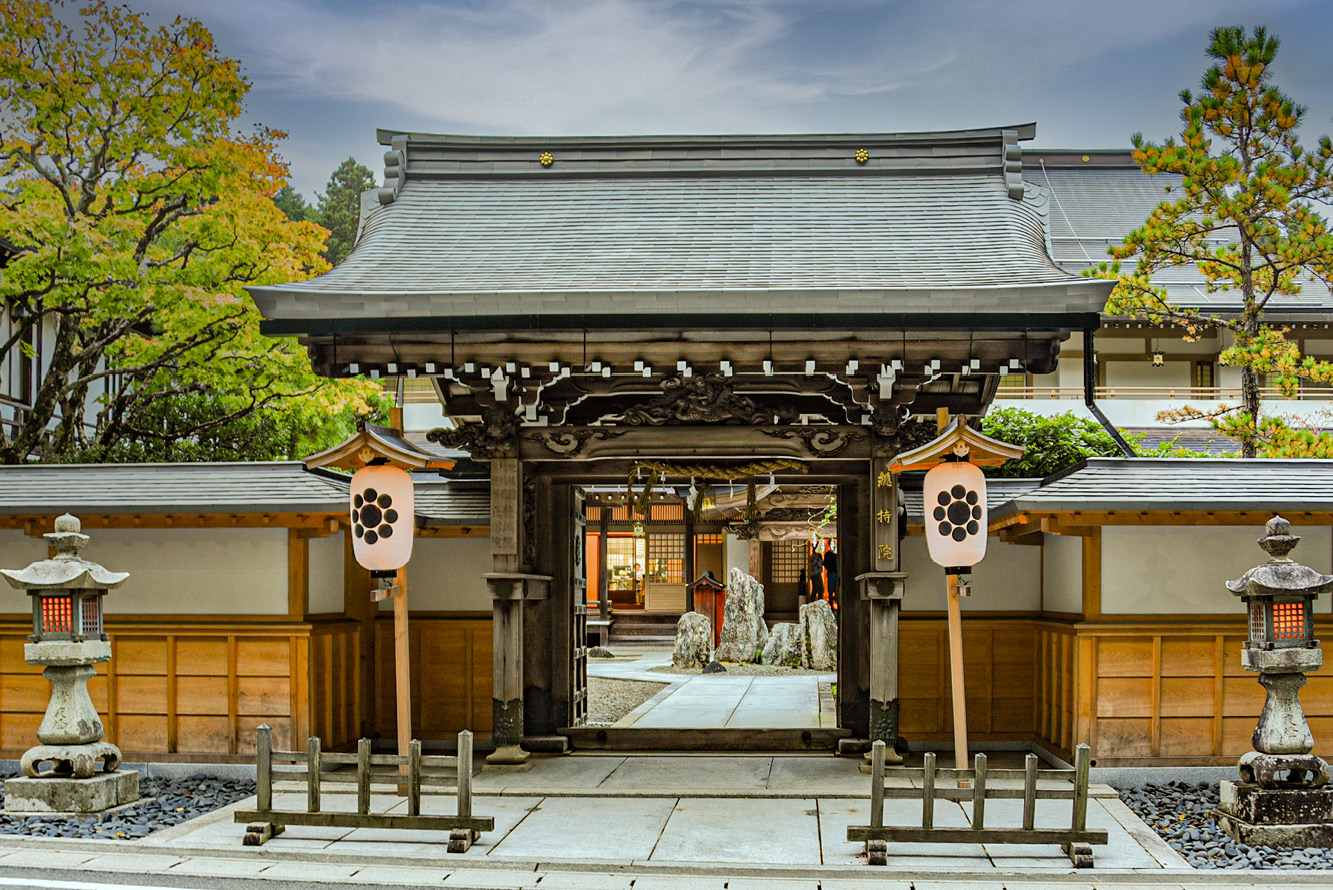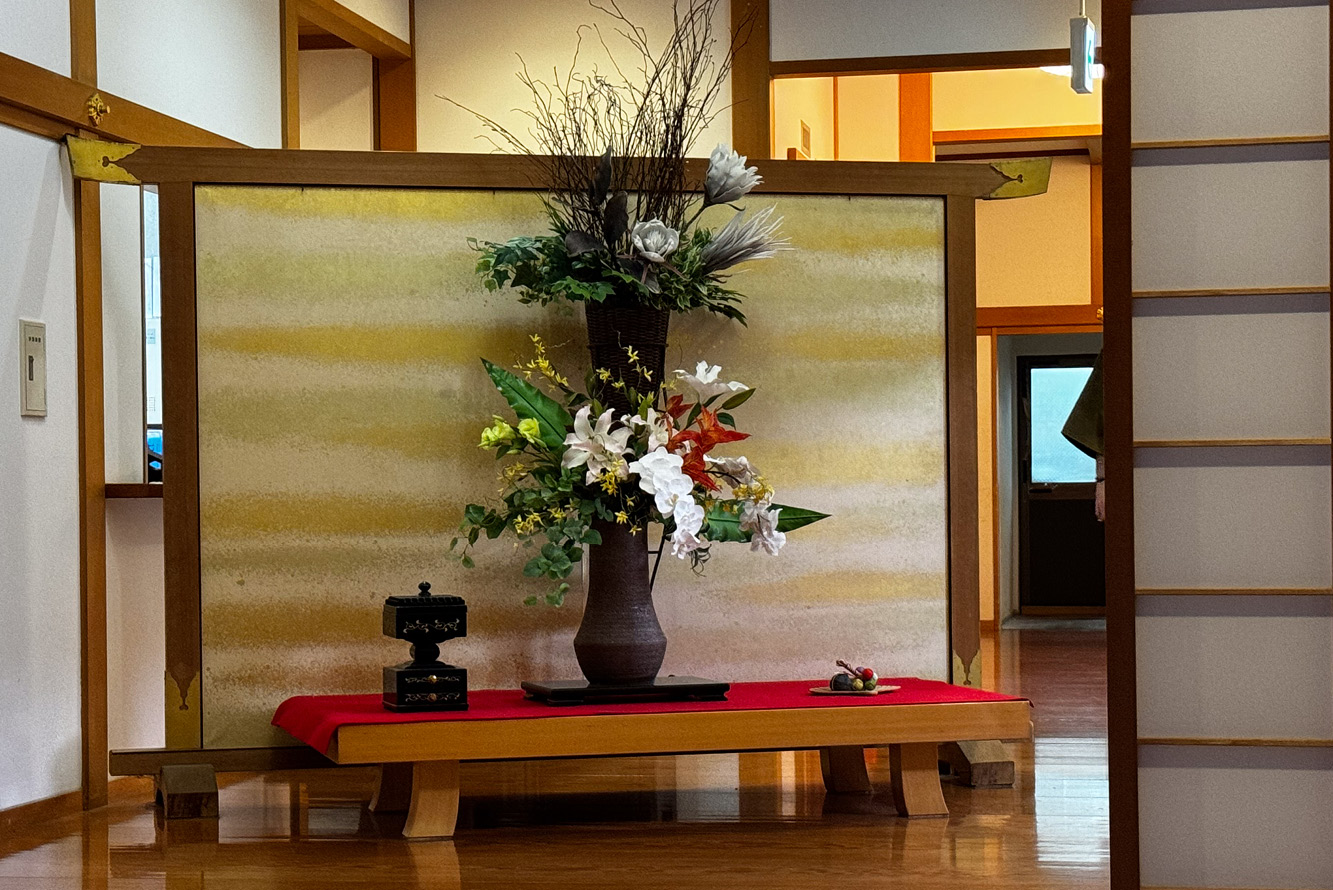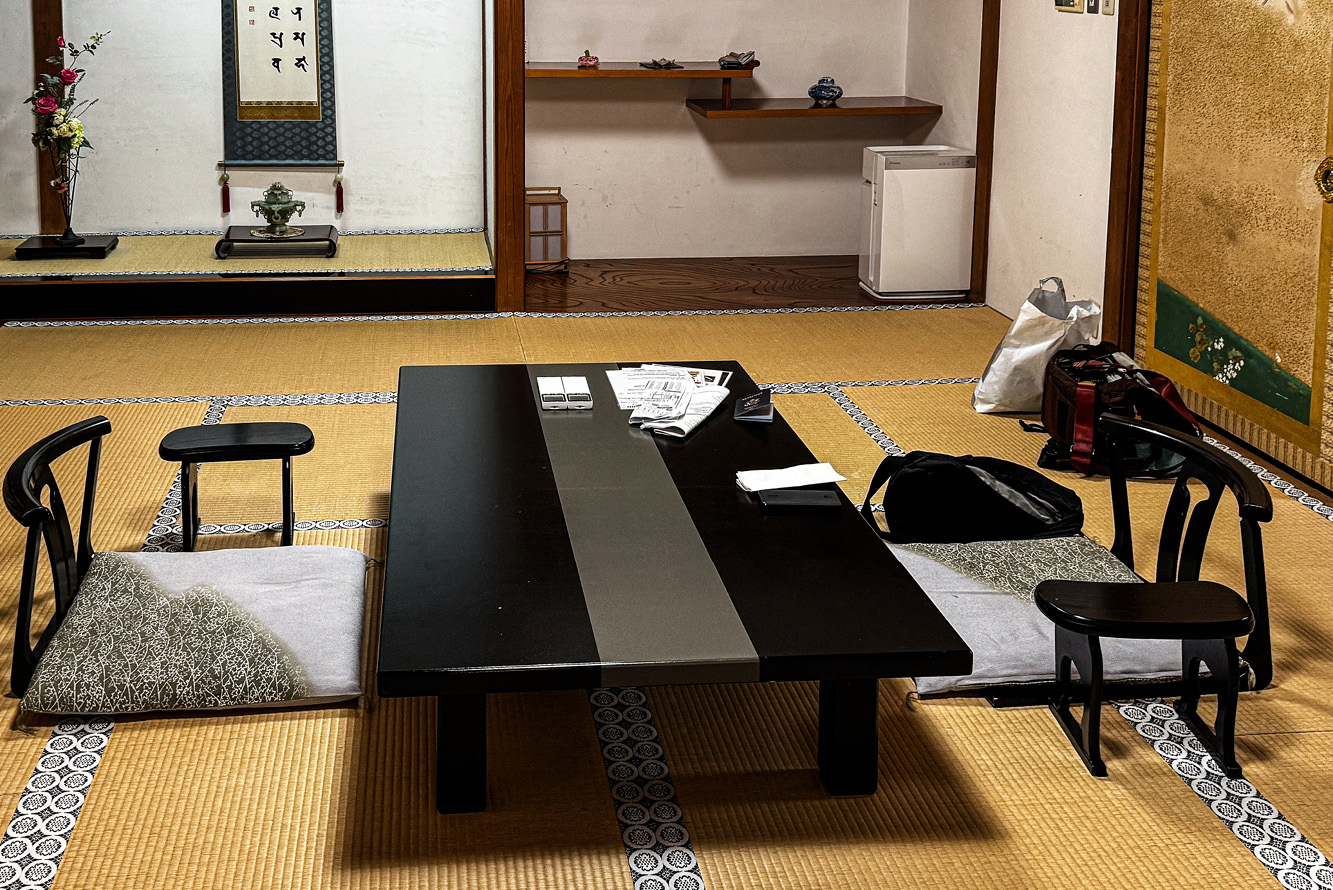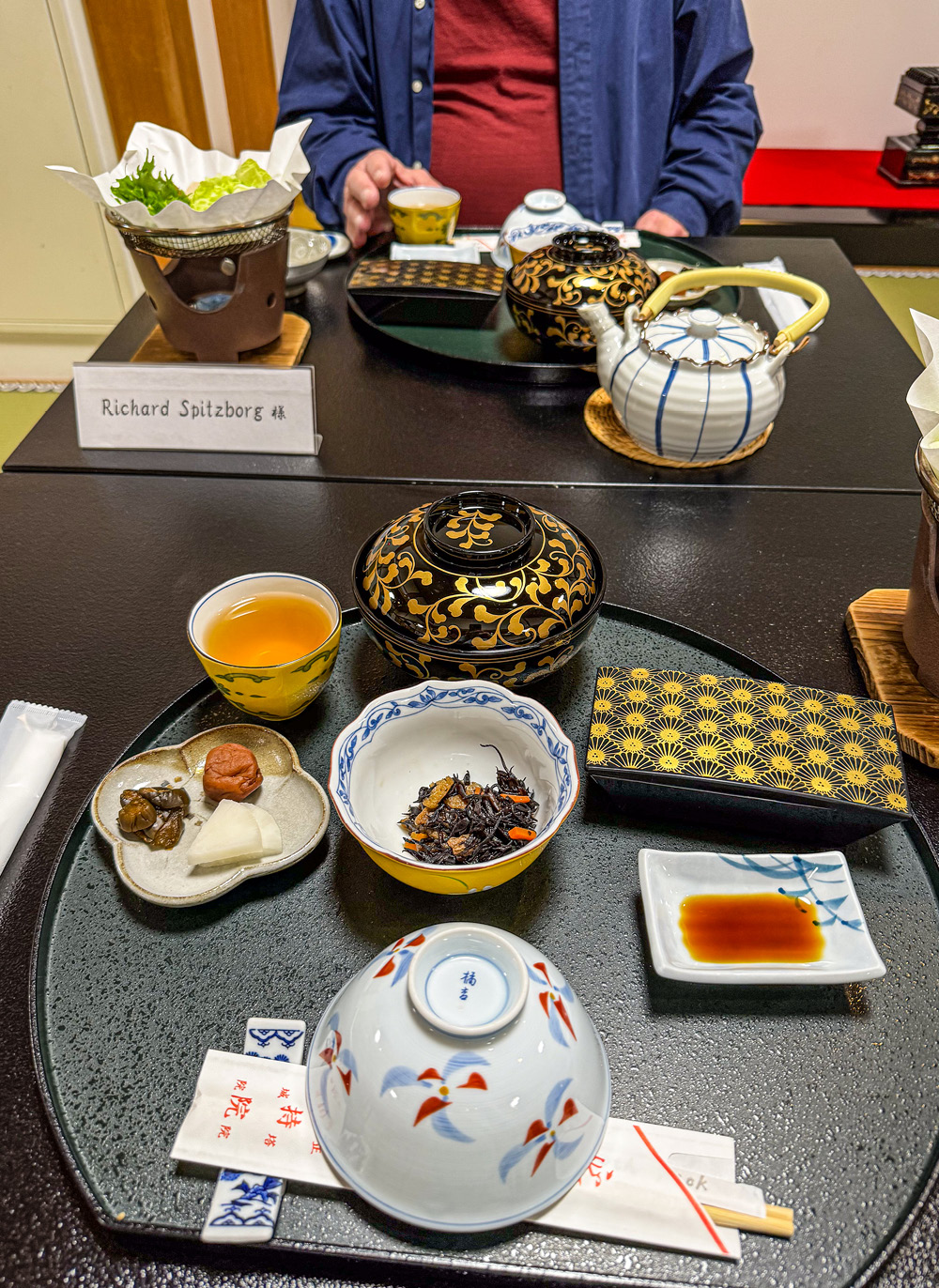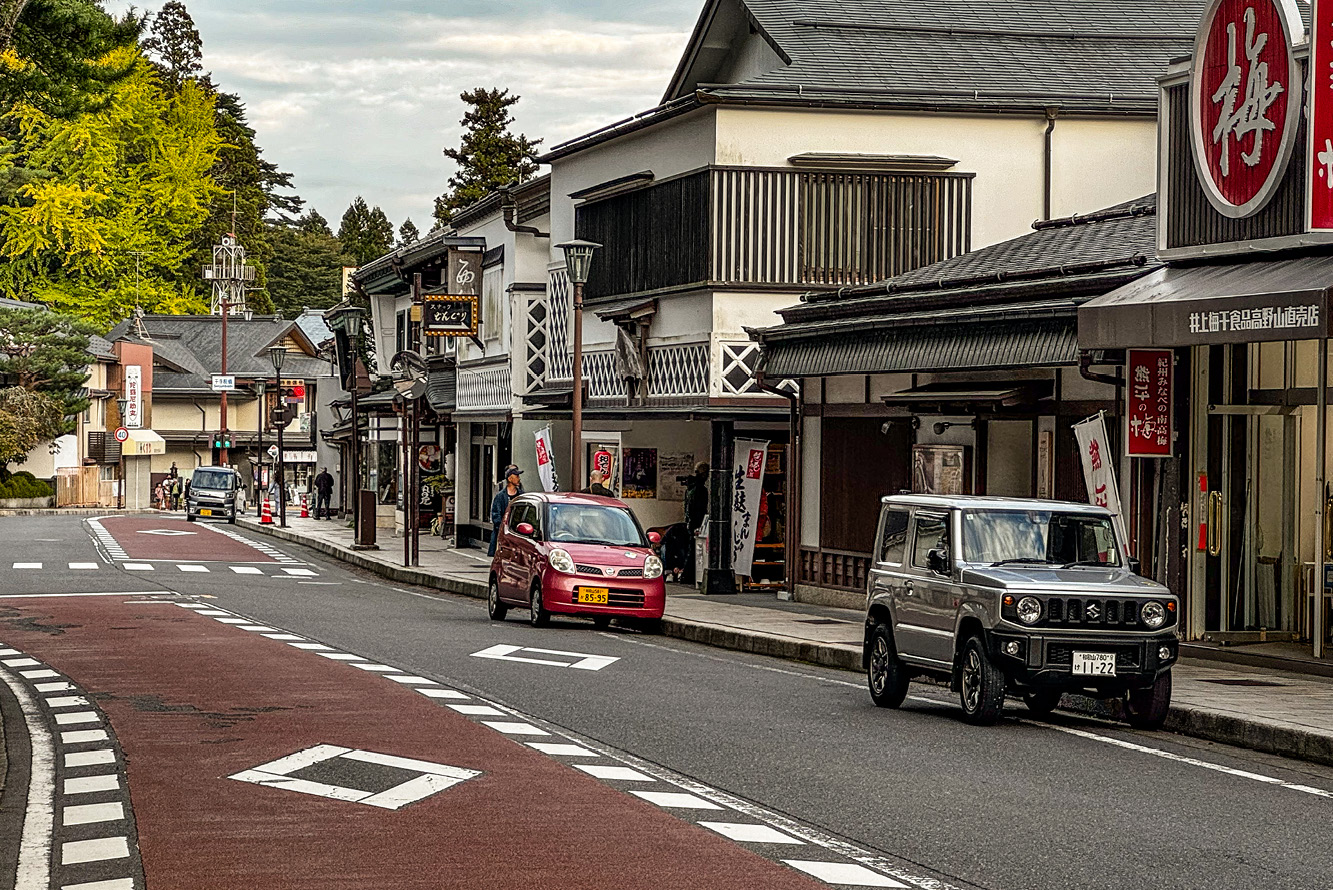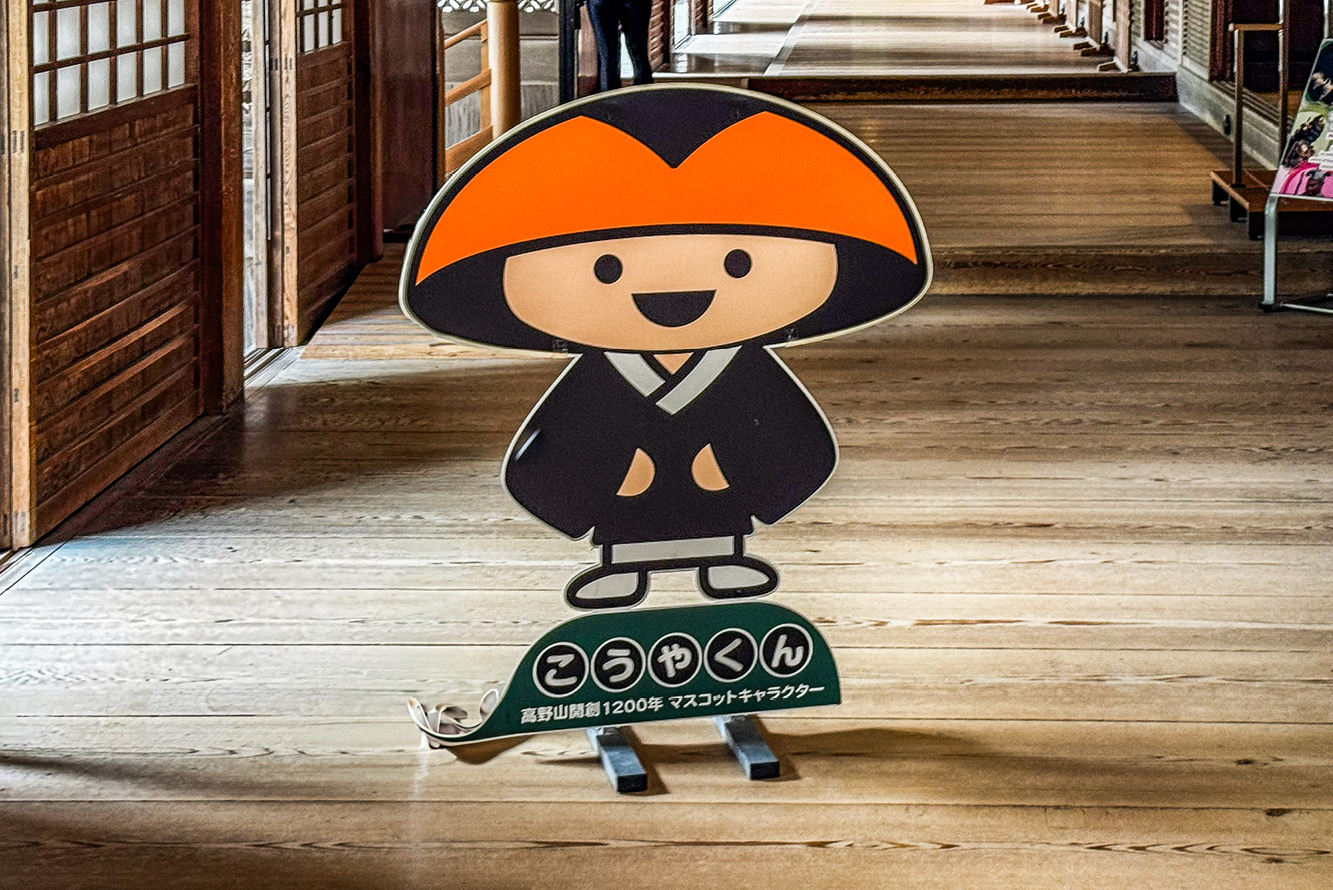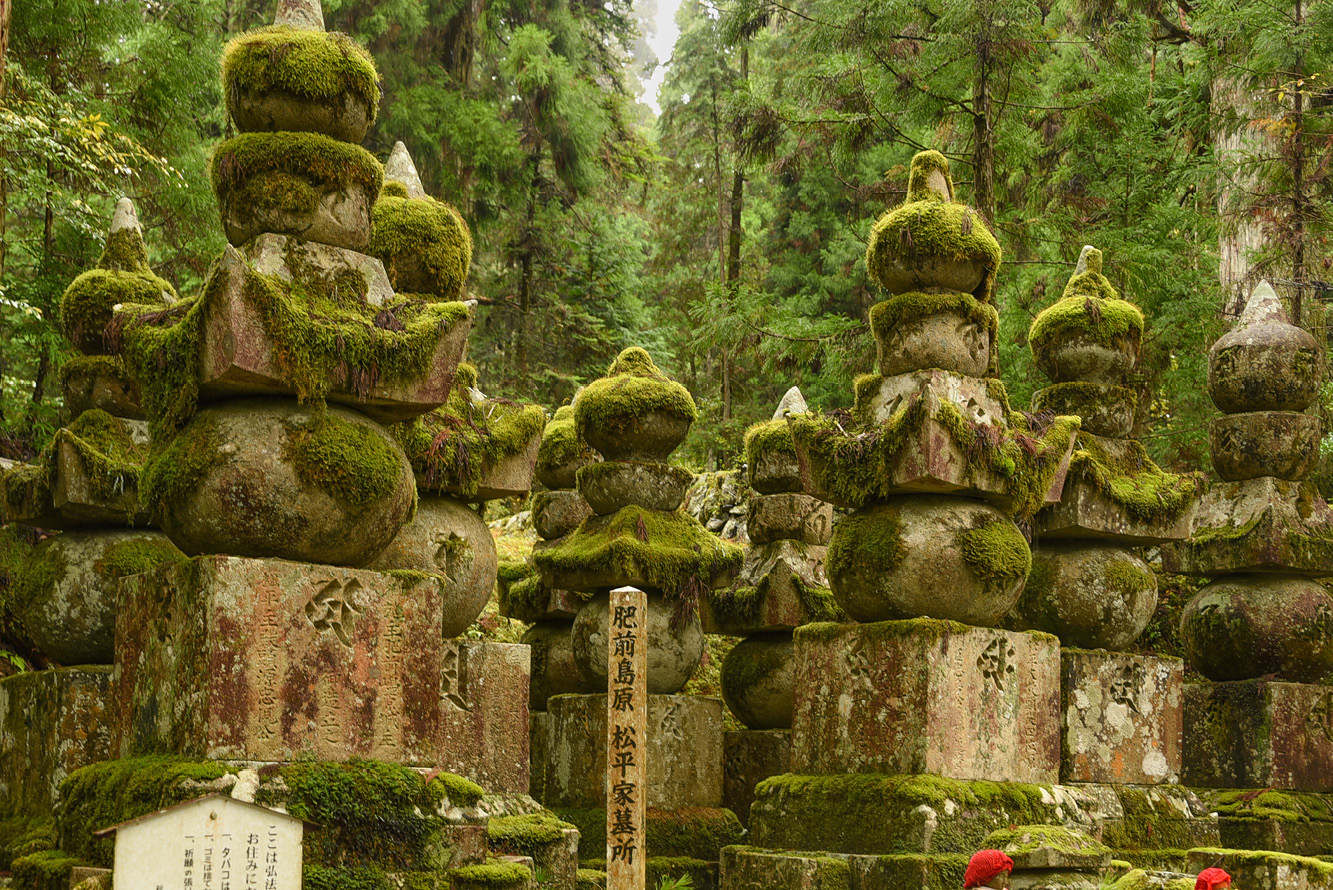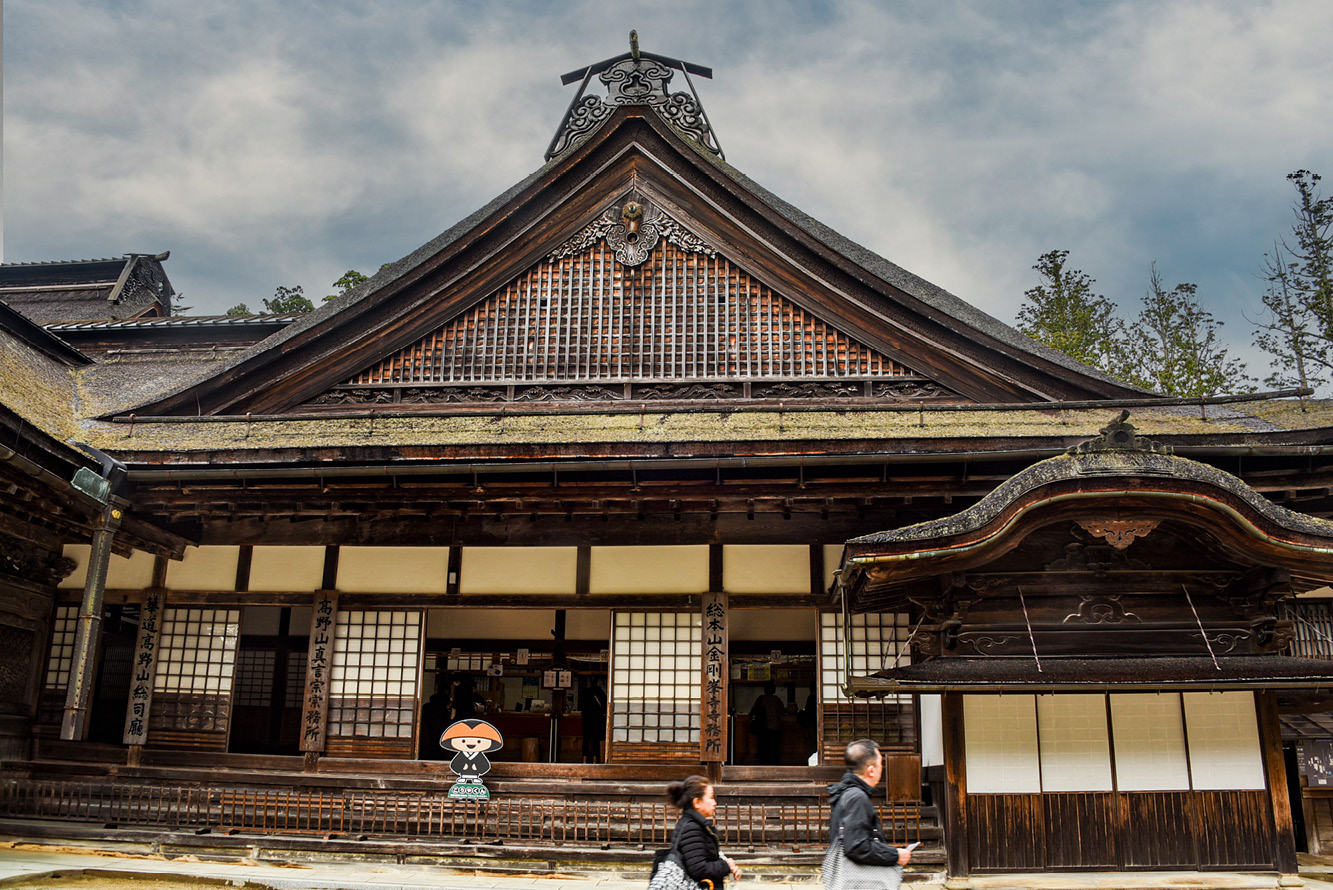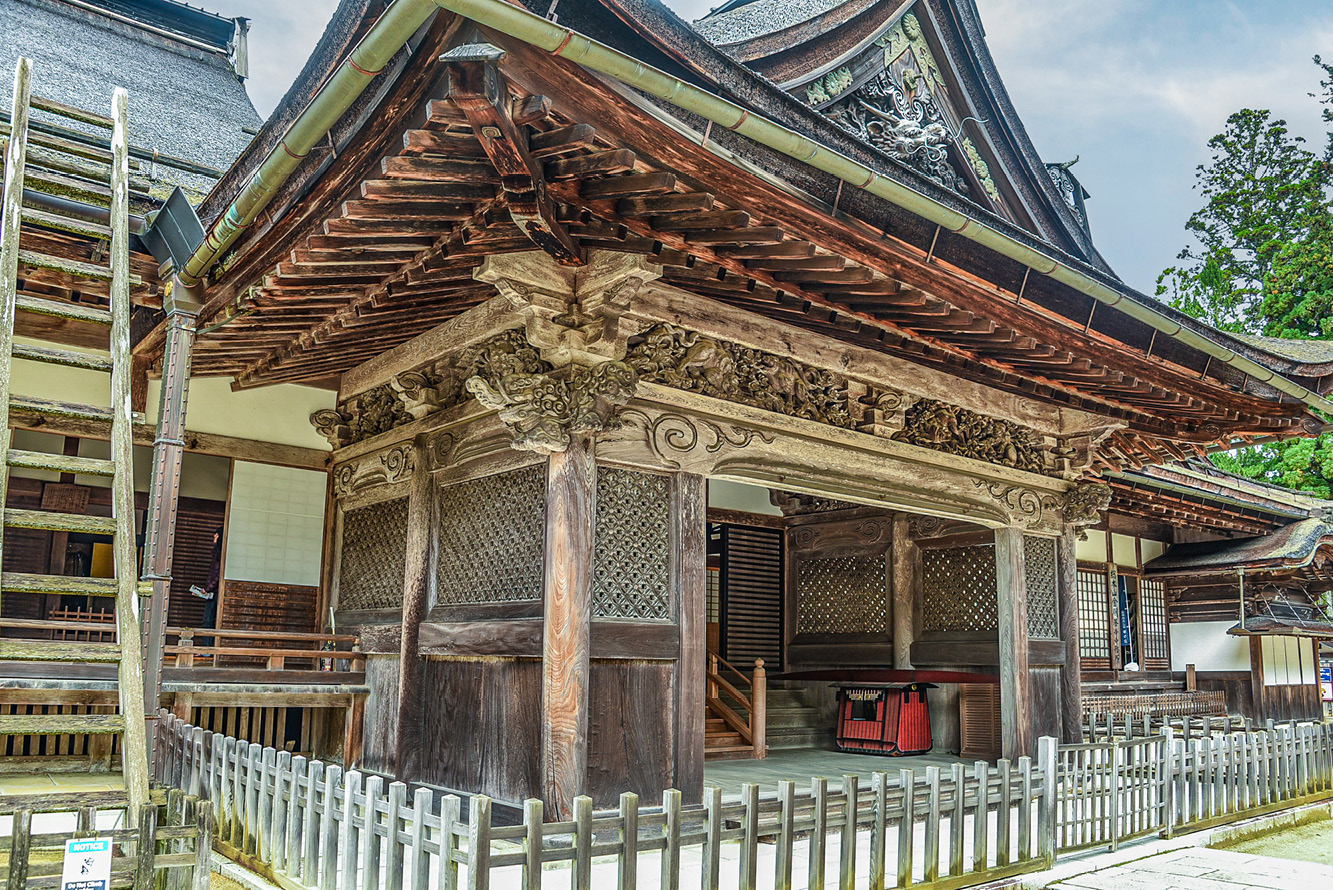As our train rounds the bend, I move to an empty seat in the sparsely filled last car to get a glimpse of the four cars ahead. I’m excited about going to the top of remote Mount Koya on this final leg of the three trains we took since leaving Osaka. This last leg of the rail journey is on a single track. Trains travel from both directions at the same time, and they arrive at the five stations on this line at the same time. The single track splits into two, and the opposing trains stop on either side of the platform to allow passengers to move on and off. Yet another example of Japanese efficiency.
Traveling by train to new locations thrills me; I feel like I’m on an amusement park ride. On this track to Mount Koya and its quaint Buddhist town of Koyasan that sits its top, nature’s beauty and humanity’s creations stream by. I’m mesmerized by the unfamiliar sights, and my mind makes up stories about them. There’s a small village nestled among hills draped in an evergreen mantle. “Why is it there?” I wonder. Our train travels through another rural town, slowing down as it approaches the station. I can see the backs of houses along the tracks revealing neat rectangular vegetable gardens; a few have pine trees trimmed in layers to resemble clouds, a style that mimics a large-scale version of Japanese bonsai.
Lights dazzle in nighttime Osaka
Getting to Koyasan is part of the experience
Reaching this point in our journey from Osaka to Mount Koya challenged our travel acumen. From our hotel early this morning with suitcases in tow, we made our way to the subway, rode several stops to the zoo exit, then wandered several blocks to the obscurely located Nankai Electric Railway Station. We bought tickets for three connecting trains that would deposit us at the foot of the mountain. Navigating up an elevator to the wrong platform, we returned to the first floor, rechecked the overhead sign and ascended in another elevator to hopefully the correct one. Our tour company’s very specific instructions indicated exact times for departures and arrivals for each segment, with only minutes to spare between connections. I was sure we would miss one of these trains trying to locate the next train. Once we left the big cities, English speakers would be rare and assistance difficult to find. My apprehension grew.
We must have worn a look of consternation on our faces, because a friendly young woman speaking enough English approached us to ask if she could help. “Koyasan,” we declared and mumbled about three trains. She took our tickets and disappeared into the crowd. Should we have given her our tickets?! Soon she returned after speaking with the station master. Yes, we were on the right platform and here’s where to look for the train number and arrival time. She remained by our side silently until our train arrived and ushered us on, as we bowed many times to thank her. (We later learned that helping strangers is a time-honored Japanese custom.)
The first train ride ended, and we prepared to quickly exit, seek out and board the second train in five minutes before it leaves the station. To our surprise, the train was waiting on the other side of the platform for all the passengers to cross and board! We hadn’t realized that this line was dedicated to travel to Koyasan, with stops for communities along the way. So trains’ arrivals and departures were coordinated. The same routine followed the end of the second leg. This time we sauntered across the platform for the train we’re on now. No problem!
So here we are. I’m busy snapping lots of photos through the window. The lead car pulls us up through dense cryptomeria, cypress, and pine forests that close around the train, darkening our car. After two hours riding the rails, the Nankai Electric train pulls into Gokurakubashi Station at the base of the mountain, and a few dozen people disembark. Our travels to the spiritual town of Koyasan, our destination, are not over, however. A funicular awaits to transport us up the mountain to Koyasan Station (the fourth leg of the journey). Nankai Cable Line’s three-car trams are themselves designed for a steep climb, outfitted with tiered seats. This one-track system splits temporarily into two tracks halfway up. A descending tram takes the right fork at precisely the same time ours takes the left, and we pass each other. Clockwork. We reach Koyasan Station at the top in five minutes.
Finally, we think, we’ve reached our destination, inhaling fresh, pure evergreen-scented air. Bottle that. But not so fast. We’re directed to one of four buses waiting to take us on the fifth leg of our journey for a 15-minute ride to the section of town where our lodgings are located.
Why go to Koyasan?
On every adventure, the explorer in me wants to “discover” the unfamiliar, sometimes startling, places or cultural aspects that are very different from my own, especially taking those paths seldom trodden by the average western traveler. Like Robert Frost claimed, “Two roads in the woods and I––I took the one less traveled by.” Remote, secluded Koyasan, suffused with the sublime aura of Buddhism, provided that allure. Not on the usual tourist circuit, our tour company programmed this “side trip” for their two American “explorers.”
So why am I here standing on this remote mountaintop on Japan’s Kii Peninsula to visit Koyasan? What goes on here that makes it so revered?
Kūkai, a Japanese Buddhist monk, calligrapher, and poet, established Koyasan as a temple settlement in 819 A.D., after returning from his religious studies in China. He brought back the teachings of a new Buddhist sect, Shingon, and chose the site of his settlement on this mountaintop plain surrounded by eight other nearby peaks, forming what he imagined a sacred lotus flower with Koyasan as its center. Shingon Buddhism flourished throughout Japan in the following centuries. Now, Buddhism and Shintoism (Japan’s indigenous religion rooted in nature worship and the veneration of ancestors) make up 95% of the country’s religious practices, making Koyasan a pillar of the spiritual community, with its 117 temples and rich culture and history.
We choose a Koyasan temple stay
We get off the bus and look around to get our bearings. A few raindrops hit our faces. Very few cars move on the streets. Koyasan’s small, tidy commercial area lies in one direction, and our two-night lodging, Souji-in Temple, lies a short walk uphill in the other direction. Souji-in is one of over a dozen temples, called shukubo, that provide accommodations for visitors. Two lighted paper lanterns on poles announce the walled compound’s front entrance, a set of heavy doors set in a wooden roofed archway.
A paved walkway splits and rejoins around a sculpture of five upright rocks set in a sea of pebbles. Spanning the classically designed building’s entrance, a gentle wooden arch attaches to the front above a set of steps leading to the porch running along its length. A pair of cupboards already holding several pairs of shoes flank the steps. Doffing our sneakers, we place them on the shoe racks, trading them for pairs of small, ill-fitting leather slippers that slip off with my first steps across polished wood floors towards the reception desk. A blue-ribbon worthy, colorful flower arrangement sits on a low red table draped with a red scarf. For check in, the reception monk escorts us to a front common room filled with ornately detailed metal furniture with plush cushions that seems out of place in the spirit of austerity.
A second monk leads us through a labyrinth of hallways lined with shoji, moveable screens of square, soft-wood frames arranged in a grid, each surrounding sheets of translucent paper called washi, made from mulberry tree fibers, that allow light to pass through. Our sparsely-furnished corner suite has a wrap-around hallway, opening to a large central room with two futons lying on the floor. The futons have quilts and plush pillows to make floor sleeping more comfortable. Tatami mats, thin carpets made from rush grass, emit a pleasant, natural fragrance. I eye the sleeping arrangements suspiciously; the image of rising from the floor for a nocturnal visit to the bathroom in total darkness confounds me.
In the center of the adjacent area, a low black lacquer dining table about 18 inches high has two cushioned floor seats. Next to each chair, a matching arm rest looks potentially useful as a support next to our futons for those nighttime rise-ups; I commandeer them for that purpose. A western-style sofa, two regular chairs, and a coffee table set up in the wrap-around hallway provide a relaxing setting for gazing at the pleasant, manicured garden with a rock and pebble stonescape at its center. It’s mid-October, and maples and gingkoes show off their red and yellow leaf shades.
The dinner hour at our temple stay provides a cultural episode
During a pre-dinner walk-about through Koyasan’s quaint downtown of restaurants and stores selling local art, household furnishings, souvenirs, and sweets and ice cream, we notice a recurring Japanese anime-style cartoon monk leaning against doorways, propped up in window displays, dangling from key chains and stuffed as toys. We find out it’s Koya-kun, Koyasan’s mascot. He’s everywhere, we discover, as we tour the sites.
At 5:30 promptly, dinner is served at Souji-in, no latecomers or second seatings accommodated. We don men’s kimonos and jackets provided in our room that make up the dress code for all meals. Appropriately attired and slippered, we head to the dining room a few minutes after the designated hour.
Then I make two mistakes. First, with shoji screens everywhere, I get confused about the location of the dining room entrance. Walking down a hallway, I hear a few muffled voices, decide I’ve found the right screen door, and pull it aside to face two guests at their table waiting to be served. “Their table is so close to the entrance,” I say to myself. Forgetting to remove my slippers (the second faux pas) I step up to squeeze past them, my ill-fitting slipper slips off, I trip and careen into a shoji screen. A monk rushes over to help me, and when I regain composure, I see fifteen tables of diners, now hushed, staring at the commotion I’ve caused. Providence is kind, and I don’t break anything.
The monk leads us to the only empty table, our names prominently displayed. We take our seats, stare at each other, and silently burst out laughing at my oafish, embarrassing performance. A server delivers the first of four vegan courses as we sip tea and water (no alcohol allowed). Artfully presented in an array of simple, yet attractive dishes of various shapes and sizes, the servings are modest, and I wonder if I’ll leave the table hungry.
Japanese monks commonly cook in the shōjin ryōri style, based on simplicity and harmony of ingredients. Each meal must have a balance of five colors and flavors. Key ingredients include tofu in all its forms, soy milk film, wheat gluten, fermented soy beans, sea kelp, dried seaweed, and the ubiquitous tsukemono, pickled vegetables. In addition to its vegetarian characteristics, the cuisine contains no onions, garlic, or other “pungent” tastes. Modest amounts of rice and soba noodles accompany dishes. I want to like the dishes but find the food bland and unfamiliar.
Gentle rain discourages an after dinner stroll; besides, a 9:00 curfew finds the front door locked, so a very early evening ends the day. Grateful for a book downloaded on my iPad, I drift off to sleep at a ridiculously early hour. The lacquered arm rest from the dining room I placed next to the futon earlier proves invaluable in the middle of the night.
Okuno-in: A cathedral of evergreens shelters a cemetery of souls
Monks hold one-hour temple prayers at 6:00 A.M. One is allowed to enter at any time; we make the second half of the daily ritual that includes much chanting. Heading to the dining room’s main entrance and removing our slippers this time, monks serve breakfast, an array of savory foods I don’t usually eat early in the morning. Promptly at 9:00, our guide for the day arrives. We’re lucky to have an energetic, pleasant woman (her name is Saki) and also a practicing Shingon Buddhist; she makes our temple experiences come alive with cultural explanations and personal references.
A foggy, misty rain falls; it provides a fitting atmosphere for our first of three site visits––Okuno-in, where Shingon Buddhism all started.
Westerners would say Kūkai, the sect’s founder, is buried here, but adherents believe he entered eternal meditation and will continue to do so until the world straightens itself out through enlightenment. In any case, once he left his body, he was renamed Kobo Daishi, Great Teacher of Buddhist Law. A mile-long cemetery serves as the impressive entrance to Kobo Daishi’s mausoleum. Towering evergreens––cryptomeria (Japanese cedar) and camaecyparis (false cypress)––form a cathedral for 200,000 graves containing the decedents’ ashes, some over 1000 years old.
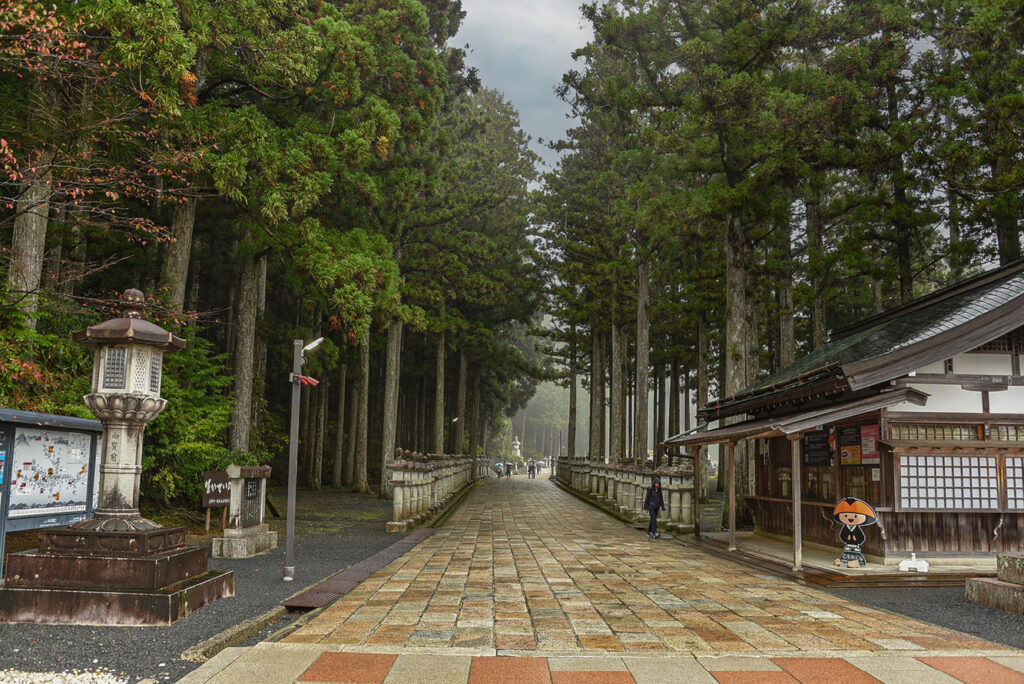
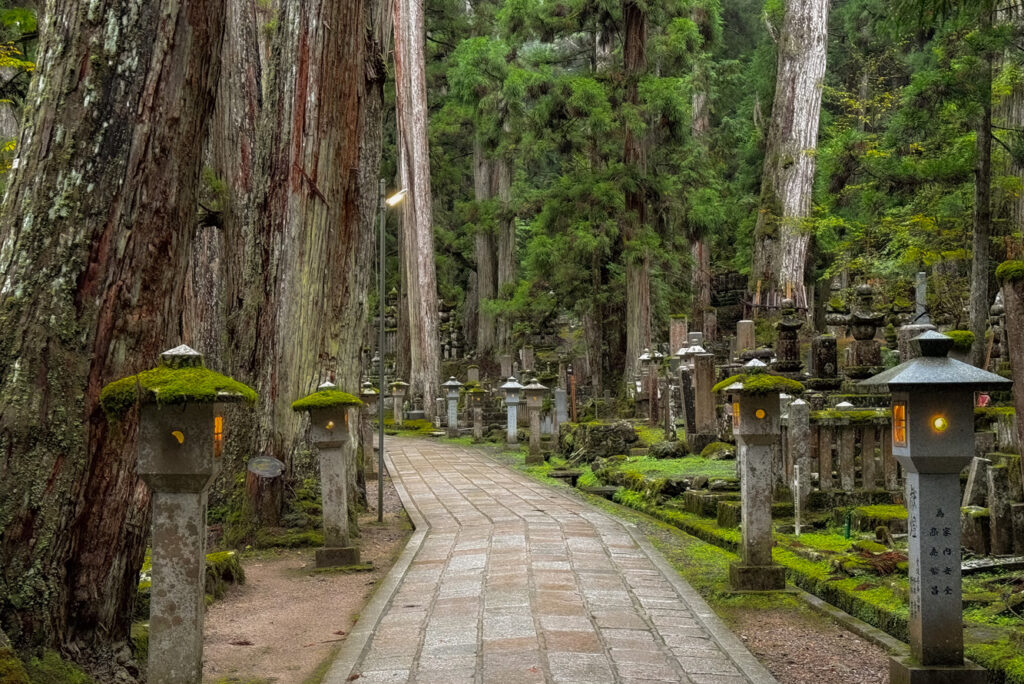
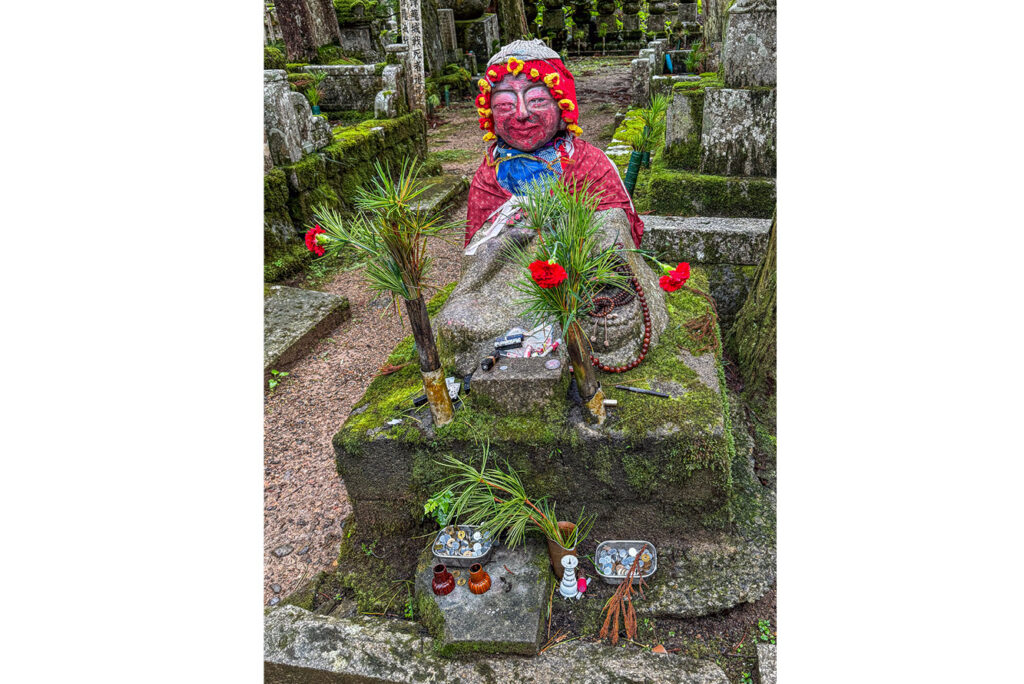
Our guide leads us on a cobblestoned walkway, lined on both sides with hundreds of lighted lanterns mounted on stone pillars, through the forest of trees and chock-a-block grave markers and statuary, creating a mammoth, hallowed space. Misty rain heightens the ethereal atmosphere. (I almost imagine an organ belting out a Bach Fugue, but that would be too noisy for Buddhists.) Moss pelts cover tops of pillars and stone images of meditating Buddhas in this damp, low-light environment. Our guide points out a pile of flattish rocks of different sizes sitting on top of many stone pillars. They represent the five elements used to understand the nature of reality and the self––earth, water, fire, air (wind), and space (ether).
From monks, high officials, feudal lords, and historical figures to modern day philosophers, writers, scientists, businessmen, and commoners––they all eternally rest here. The living vie to be buried near the forever-meditating Kobo Daishi, hoping to discover a path to salvation.
We arrive at Gobyo-bashi Bridge spanning a small stream; it marks the entrance to the sacred grounds of the inner sanctum containing the worship hall and mausoleum. Fourteen bronze statues of guardians and deities line up next to the bridge. They’re called the Splashing Jizo; it’s mostly adherents who pour water over each figure as a prayer for their ancestors. We follow suit to honor the site.
Priests feed Kobo Daishi in eternal meditation at Okuno-in
Adherents to Shingon Buddhism believe that Kūkai didn’t die; instead, he entered an eternal meditative trance (samadhi) as Kobo Daishi and is still alive today. As such, he needs his daily bread. Providing him with ritual offerings is what we’re about to witness.
Two priests in dark saffron robes emerge from a building with a plain wooden chest covered in a raincoat of plastic and suspended from a pole to mount on their shoulders. An elder monk leads them across a plaza, and they approach the Gobyo-bashi Bridge. They stop, bow, cross the bridge, and proceed down the walkway to Torodo Hall, the main worship hall. Steady rain begins to fall, and the crowd of 30 visitors pop open their umbrellas. On signal, we all follow the same bowing procedure at the foot of the bridge and put away our cameras, as photos, food, and drink are prohibited beyond this point.
Apparently, inside Torodo Hall (called the Hall of Lamps) contains 10,000 eternally lit lanterns donated by devotees. I don’t see them, as we crowd into the hall behind a wooden railing. Chanting monks conduct a service, though there’s no audience response involved. After a few minutes, I wander outside behind the hall to glimpse Kobo Daishi’s mausoleum. I assume his meal has been delivered, as the chest of daily victuals is nowhere in sight. A few other visitors mumble chants quietly in front of the house.
Our guide chooses another path back through the cemetery that contains more statues. A few are “dressed for winter,” wearing red knitted caps and, occasionally, red shawls, placed there by families and friends. Small red-capped Buddha images identify the graves of children.
Back out on the street, I realize I’ve experienced an extraordinary moment, enveloped in the liminal space between reality and spirituality.
Kongobu-ji Temple holds rare fusumo paintings and Japan’s largest rock garden
Our next stop––Kongobu-ji Temple, Shingon Buddhism’s ecclesiastic headquarters in Japan and the most important structure in Koyasan. We enter the compound through the main gate, which happens to be Koyasan’s oldest structure. Mascot Koya-kun greets us from the steps. Originally built in 1593 and rebuilt again in 1861, the handsome main hall and connecting building stretches 200 feet across. A grand, intricately-carved Great Main Hall entrance once only accommodated the emperor and his family, chief priests, and advisors. Everybody else used a much smaller, unadorned entrance. The presence of two portals emphasized the distinctions of status and power.
Balanced on the peak of the roof, two tubs of water sit, originally designed to prevent the wooden structure from burning down. My mind sees monks scrambling onto the roof at the first sign or smell of a nearby fire outbreak and tipping the barrels of rainwater over the tightly packed shingles of cedar bark to keep flying embers from igniting them.
In front of the main edifice, a squat, trapezoidal gabled building, called Shoro, served as the bell tower. Its lower portion flares out, and the entire gabled structure has a special architectural designation called Hakamagoshi, because the shape of the base resembles the flared pants of traditional men’s formal dress.
As we enter the main hall through a third entrance created for the public, a stand-up image of Koya-kun welcomes us. (I’m really enjoying this ever-present character.) The carved woodwork and halls of shoji screens that separate rooms in this sprawling space present an elegant, classic interior. Kongobu-ji Temple features two famous artistic gems that captivate me. First, exquisitely painted sliding doors contain unique quintessential Japanese scenes called fusumo paintings, finished in the seventeenth century by artists of the respected Kano school. Landscapes of willow and plum trees, deer, cranes, flowers, and seasons of the year, as well as historical events and mythology, fill these moveable walls that create rooms designated for special activities. Again, no photos allowed.
Rounding a corner of a hallway, the largest rock garden in Japan lies before us. Completed in 1984, Banryutei Rock Garden contains 140 naturally formed rocks arranged to represent a female and male dragon—they’re the temple guardians—swimming out of clouds formed by raked pebbles in a curving pattern. As beautiful and serene this iconic ground sculpture is, I struggle to visualize the fantastical scene it’s supposed to depict. Before we leave the site, I duck into the small gift shop to buy two Koya-kun images.
Danjo Garan is a Buddhist temple wonderland in Koyasan
The crown of today’s dive into the history and sublime architecture of Shingon Buddhism sits right across the road from our temple lodgings behind a veil of trees. (By now, you can guess the character who’s standing there to greet us as we enter the grounds.) Twenty temples and halls occupy this quiet, reverent campus called Danjo Garan, designated by Kobo Daishi himself (Kūkai, when he was alive) in the ninth century, now considered a living museum of Japanese history and art. Most of the original all-wooden structures burned down, some several times, usually from lightening.
Immediately, Konpon Daito, the Great Pagoda, grabs my attention. First constructed by Kūkai himself in 819, the 150-foot, two-tiered structure, recently painted a vermillion red, was last rebuilt in 1930 after five fires destroyed the pagoda over the centuries. This time, builders poured concrete walls and covered them with elaborately-carved wood to withstand total destruction, just in case. Konpon Daito’s prominence derives from its location as the center of the figurative lotus mentioned earlier that’s formed by eight surrounding mountains with Mount Koya’s plain as its heart. A statue of the Cosmic Buddha stands inside the pagoda.
Next to the pagoda, equally celebrated Kon-do Pavilion holds important ceremonies and lectures. Also constructed in 819 by the ever-energetic Kobo Daishi, he gave his religious talks to the early adherents of Shingon Buddhism. Kon-do enshrines the Buddha of medicine and healing with a statue inside. Nearby, impressive vermillion-red Chu-Mon Gate once served as the main entrance to the complex. As with everything else here, the Gate burned down, the last and seventh time in 1843. The spanking new structure was rebuilt in 2015 on its 1200th anniversary! (Yet another example of “how time flies.”). The gate houses four larger-than-life images of deities who fiercely guard Danjo Garan, none of them looking like they want to be your friend.
The rest of the pagodas and halls honor various deities and serve dedicated purposes. One hall hosts major religious ceremonies, another is reserved as a sacred worship area. Other buildings include a bell tower, library, portrait gallery, and a temple that celebrates the tenets of Shintoism. This magnificent collection of structures create a temple wonderland with its pervasive serenity, the beating heart of Koyasan.
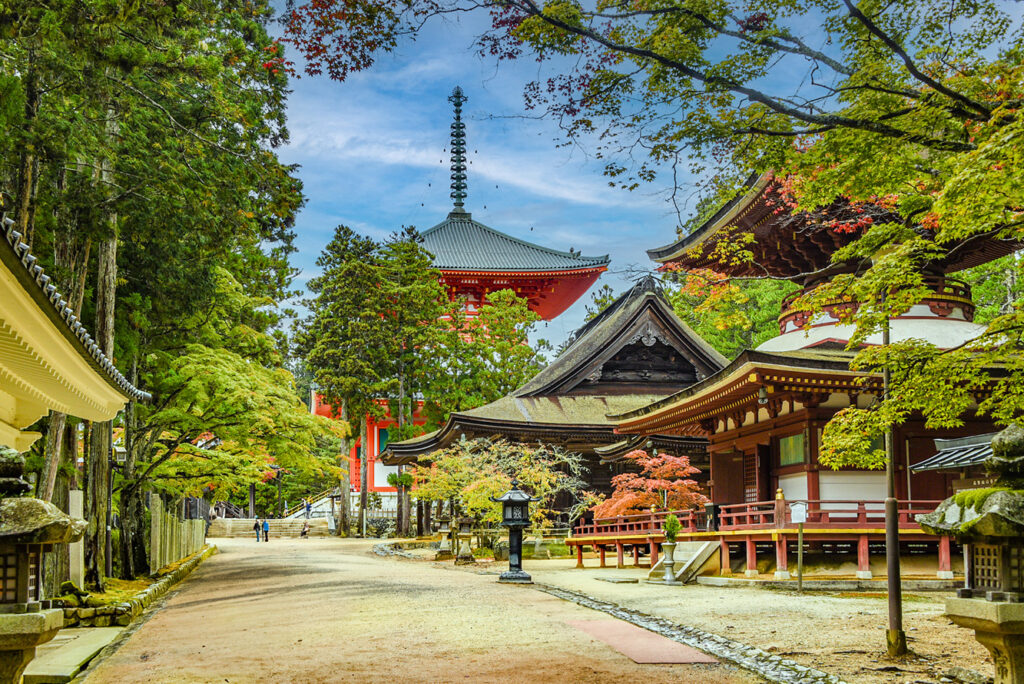
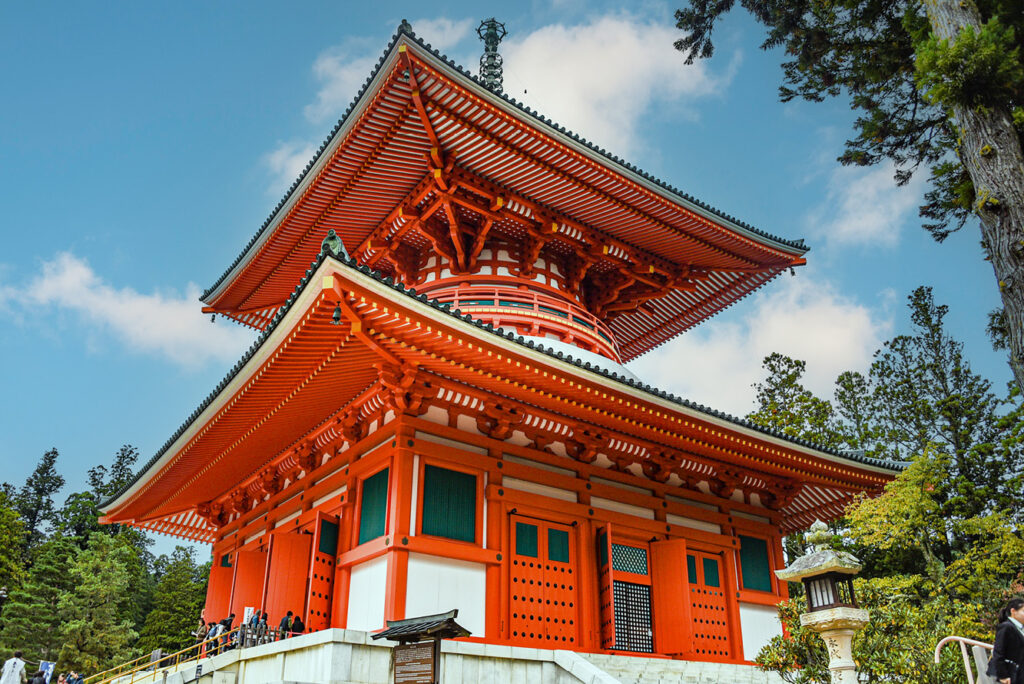
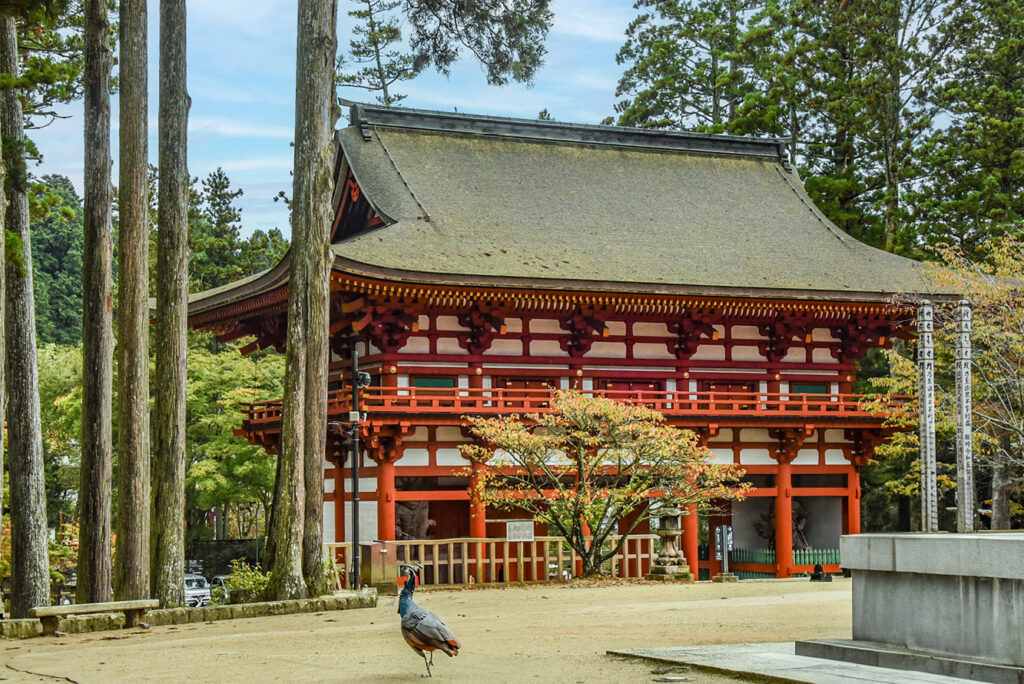
Exhausted from the day’s smorgasbord of visual and spiritual delights, we say goodbye to our guide and quickly change into kimonos and socks (I shun the slippers) to meet the 5:30 dining deadline. Despite the unexpected challenges of temple living for two days, the kind monks and authentic architecture of Souji-in Lodgings made our stay memorable. In the morning, a mad dash for the bus to take us to the Koyasan cable car terminal for a ride down to the base of the mountaintop, then three trains to return to Osaka (and a platform bed!), complete three days of an extraordinary experience in Koyasan, my personal “discovery” from three weeks in Japan.
If You Go
(Information as of July 2025)
GETTING THERE:
Most major airlines fly to the two largest international airports:
- Tokyo-Haneda (HND)––closest to Tokyo center, with more and cheaper public and private transportation options into the city. Also, Haneda is the domestic airport hub for connecting flights to destinations around the country.
- Tokyo-Narita (NRT)––Japan’s largest airport, offering a broader range of international flights, but with a longer travel time into Tokyo. Traveling from the west coast of the United States, some of the cheapest flights to Tokyo travel to Narita.
GETTING TO CENTRAL TOKYO FROM HANEDA:
- Tokyo Monorail: popular option that’s a balance of speed, convenience, and affordability. A one-way trip to Hamamatsucho Station costs about ¥470–¥520 ($4–5). The monorail is covered by the Japan Rail Pass.
- Keikyu Line: a direct line to Tokyo, including popular central Tokyo neighborhoods
- Bus: cover most popular locations in the city, but not as frequent as the trains
- Taxi: relatively expensive option, with fares to central Tokyo costing between ¥6,000 ($40) and ¥11,000 ($70), depending on the destination neighborhood.
FROM TOKYO TO OSAKA:
- Train––from Tokyo Station, take the Tokaido Nozomi Shinkansen (bullet train) to Osaka. Around 2-1/2 hours. Cost––$106.24. Recommended.
- Fly––from Haneda to Osaka. 1 hour flight. Several flights daily. Cheapest flight––about $45
FROM OSAKA TO KOYASAN:
- Nankai Koya Line––from Nankai Namba Station to Gokurakubashi Station at Mount Koya. About 100 minutes for about $12. Take the Nankai Cable Car 5 minutes up the mountain to Koyasan Station for $3.41. Take a bus into town.
ADMISSION TO SITES:
- Most sites require admission fees. Combination Ticket for Visiting Temples (called the Common Ticket) available at Koyasan Shubuko Association information Center. Admission to 6 major sites. Cost––$10.24.

